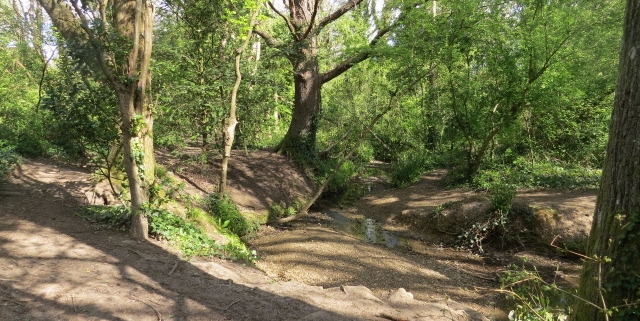
Binstead Wood
Binstead Wood is a small woodland on the edge of the Binstead housing estate. The site has some impressive oak trees. Look out for squirrels and signs of dormice. Binstead Stream meanders through.
What to look and listen for …
In spring, look for lords-and-ladies, also known as ‘cuckoo-pint’. It has large, arrow-shaped leaves, and leaf-like flower heads that curl around a long inner spike carrying tiny, yellow flowers. This spike eventually produces an upright stalk of bright red berries. Look out for nuts! There are red squirrels and dormice in Binstead Wood and they leave distinctly different marks from gnawing the nutshells. There are a lot of fallen trees in Binstead Wood, we leave them on site as they are excellent habitats for mammals and insects and you can see shiny hart’s tongue fern as well as maiden hair fern. There are lots of mosses and lichens on the trees – usually a sign of clean air.
Rooks love the trees by the glade at the site entrance, and blackbirds, robins, great tits and bluetits are all commonly heard. Listen to Binstead Stream babbling through the woodland,
… and smell and touch
Stinking iris is one of two iris species native to Britain, the other being the Yellow Iris. It is known as “stinking” because some people find the smell of its leaves unpleasant when crushed or bruised, an odour that has been described as beefy,
Poke our celandine – lesser celandine has between 8 and 12 petals. It is a member of the buttercup family and flowers in early spring. Greater celandine is a member of the poppy family with four petals that do not overlap. Despite the name, they are not related! Hug our trees, particularly the old oaks and feel free to collect holly, ivy and bay for your winter wreaths.
Nature at home and activities on site
We have produced a super Colouring Sheet for you to download and complete at home. We have also produced an I Spy Sheet and Map for you to print at home, or download to your phone and take to the site. And become a Bug Bunch Ranger. All these activities and resources can be found here.
Managing the site
The site requires regular treework. Binstead Wood has been badly affected by Ash dieback and we will need to remove a number of trees next winter.
How to get there
On foot/By bike – Public footpath R112 leads through the woods from Hillrise Avenue to Play Lane. There are two cycle racks at the centre of the site.
By bus – Hillrise Avenue stop (Route 37) is adjacent to the site entrance. (Bus Timetables)
By Car – On street parking is available on Hillrise Avenue and surrounding streets. Please park considerately. Approximate code for your sat nav is PO33 3UH.
what3words for entrance from Hillrise Avenue ///mass.detail.translated
Access
Paths through the site are unsurfaced and can be muddy particularly during the winter months. There are no internal gates or stiles. There are two benches within the site. One is at the centre of the site where several paths meet the bridleway.
There are cycle racks and an Information Pillar at this point. The site Information Pillar has a QR code that links to an audible description creating a mind’s eye view of the area to allow a visually impaired person to enter with confidence. The information pillar also has a QR code that links to a map and activities. There is also a site map on the Information Pillar.
There are no nearby public toilets. The nearest toilets are in the town of Ryde.
We have written an Access Statement for this site. This includes mobility and sensory issues and opportunities. We welcome feedback from users..

We have produced an audible description creating a mind’s eye view of the area to allow a visually impaired person to enter with confidence. It will describe the entrance, the size of the area, where to find further information or help and any major obstacles or features. Information has been produced by visually impaired people ensuring it is useful and accurate. Access the description by scanning the QR code to the left of this text on your phone or tablet, or by clicking here.
Get Involved
There are various ways you can help improve and maintain our sites. We rely on volunteers to help with many tasks on our sites and also need people who are happy to regular visit the site be our “eyes and ears”, this means we can respond much quicker to issues. Our shop raises money to support our work and needs a team of volunteers. Or maybe you would like to help us with events. Find out more here.
You can also help by becoming one of our regular supporters. Even giving a few pounds each month can make a real difference, with your donation being invested into site management and improvement work to benefit site visitors and look after our precious wildlife. Sign up here.
